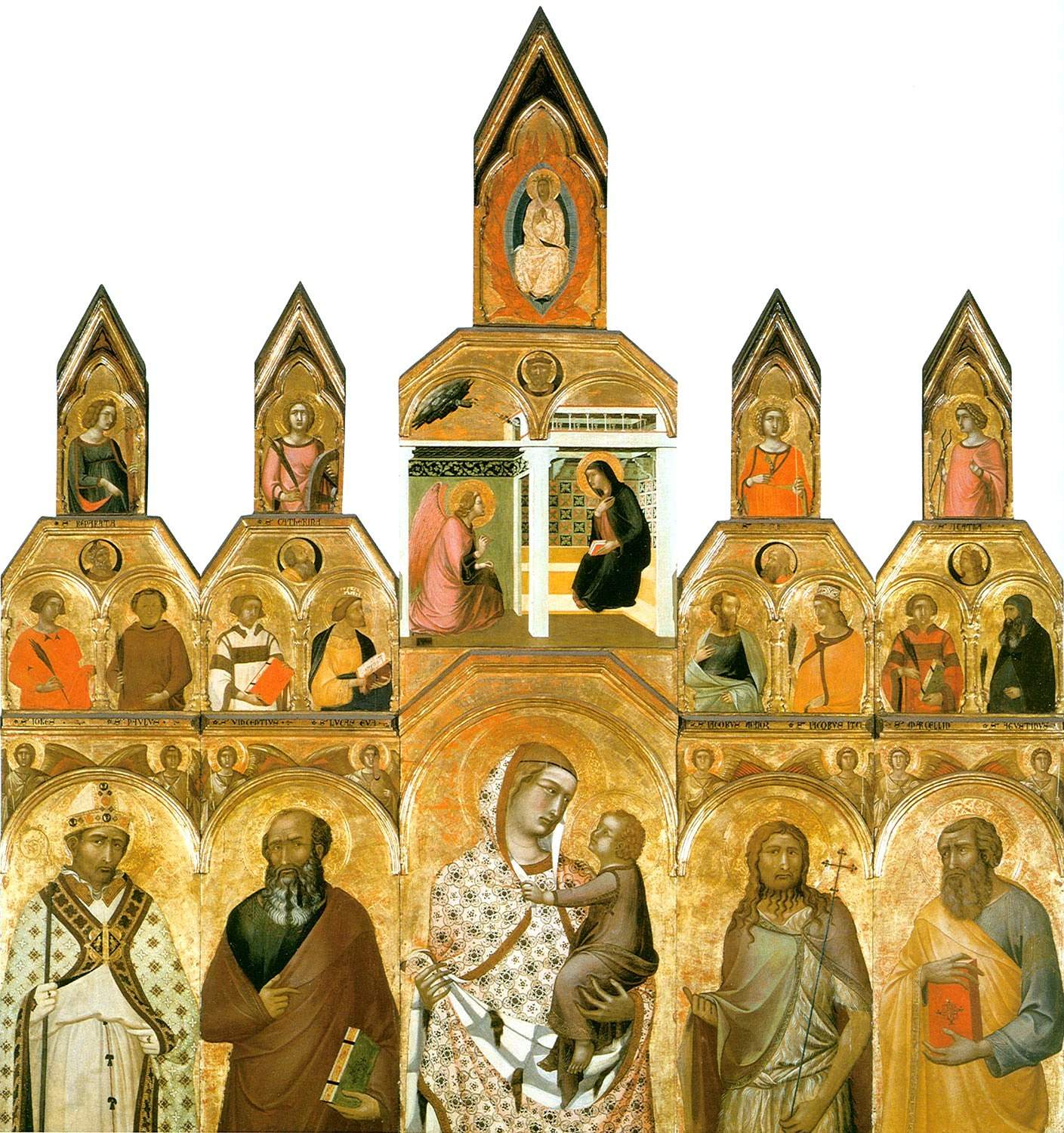The restoration of the Tarlati Polyptych, a masterpiece by Pietro Lorenzetti (Siena, c. 1280-1285 - 1348) dating from 1320 and housed in the church of Santa Maria della Pieve in the center of Arezzo, has been completed. The work, named after its commissioner, Arezzo bishop Guido Tarlati (Arezzo, ? - 1327), who commissioned Lorenzetti with a contract dated April 17, 1320, is one of the most splendid masterpieces of all Sienese painting and medieval art in general: a complex work that features in the central panel the Madonna and Child, dressed in a gilded brocade dress, lined with fur and decorated with blue quadrilobes, and in the side panels the Saints Donatus, John the Evangelist, John the Baptist and Matthew, while above is an Annunciation flanked in turn by four pairs of saints (John and Paul, Vincent and Luke, James the Greater and James the Less, Marcellinus and Augustine), while the cusp bears anAssumption and is flanked by four female saints (Reparata, Catherine of Alexandria, Ursula and Agatha). The work also bears the signature of the author: “Petrus pictor, quondam Lorenzetti qui fuit de Senis” (“The painter Pietro del fu Lorenzetti who was from Siena”).
The polyptych, an uncommon case of a medieval work still located in the place for which it was conceived, is horizontally divided into five elements: a large panel in the lower register, a smaller one of trapezoidal shape and divided into two parts in the upper one, and a cusp to close it vertically. Today it appears without the monumental frame with which it was equipped in ancient times and without the predella.
The work probably underwent an initial cleaning in the 19th century, when the church of Santa Maria della Pieve was restored. The first complete intervention, however, was in the early 20th century, when some gilded wooden columns were added between the figures in the main register and those of theAnnunciation, then removed in 1976 in the last restoration, carried out by Carlo Guido and Nespoli Carpentry under the direction of Anna Maria Maetzke of the Superintendence of Arezzo. The restoration was necessary because a deranged man attempted to set fire to the polyptych, but succeeded only in causing some minor damage to the back and the wooden structure. During the work, the structure was consolidated and it was discovered that the pictorial surface had been ruined in the past by soda cleaning and heavy paint applications. In turn, the 1970s restoration made use of strong solvents for cleaning (and no longer in use today, but which constituted the state of the art at the time), and the gaps were supplemented with watercolor and varnish.
The current work was directed by Paola Refice of the Superintendence of Siena, Grosseto and Arezzo and carried out by the R.I.C.E.R.C.A. (Research, Investigation, Conservation and Restoration Consortium Aretino) studio, which boasts an all-female team consisting of restorers Paola Baldetti, Marzia Benini and Isabella Droandi. The goal was to review the 1970s restoration, check the painting’s state of conservation and proceed with a systematic cleaning of the gold backgrounds (an operation conducted only partially in 1976).
The Tarlati polyptych was therefore subjected to careful non-invasive scientific investigations (UV, infrared, X-rays and others), which revealed, the R.I.C.E.R.C.A. studio reports, important information about Pietro Lorenzetti’s execution technique, the woodwork, and the pigments he used. This was followed by a review of the functionality of the support, with an intervention to improve resistance to the climatic changes affecting the church. The wings of the polyptych were made self-contained through the cutting of the crosspieces, and each of them underwent a treatment to prevent attacks by xylophagous insects. The painting was cleaned through organic solvents, aqueous solutions and emulsions, with the aim of avoiding any stress to the work. Once the cleaning was finished, the gaps were filled in, through watercolor (and minimally in varnish) paints. The restorers of R.I.C.E.R.C.A. also let it be known that several specialists visited the workshop during the restoration (among them, Christa Gardner von Teuffel, Julian Gardner, Giorgio Bonsanti, Franca Falletti, Roberto Bartalini and Alessandro Bagnoli).
Each phase of the work was documented and photographed in preparation for the final report: a wealth of important data that will be used to better study the work and to provide help for possible future interventions. It was scheduled to be delivered to the Pieve di Arezzo last April 17, but the work was delayed due to the health emergency.The polyptych will therefore reach its location on November 8 with a mass celebrated by Archbishop Riccardo Fontana and parish priest Alvaro Bardelli.
Image: Pietro Lorenzetti, Tarlati Polyptych (1320; tempera and gold on panel, 315.5 x 293.6 cm; Arezzo, Santa Maria della Pieve)
 |
| Arezzo, finishes restoration of Tarlati Polyptych, masterpiece by Pietro Lorenzetti |
Warning: the translation into English of the original Italian article was created using automatic tools. We undertake to review all articles, but we do not guarantee the total absence of inaccuracies in the translation due to the program. You can find the original by clicking on the ITA button. If you find any mistake,please contact us.